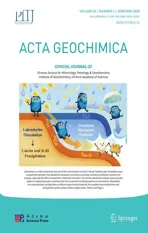The late Early-Paleozoic granitic magmatism in Northwestern Fujian,China: constraints on intraplate orogeny in the South China block
2024-03-06WanLiGaoZongXiuWang
WanLi Gao • ZongXiu Wang
Abstract The Early Paleozoic tectono-thermal event was a significant orogenic activity during the Phanerozoic era,which had a profound impact on the early crust of the South China Block (SCB) and established the foundation for later tectonic activity.The Wuyi-Yunkai orogenic belt in Southeastern China was extensively exposed to Early Paleozoic magmatism,the genetic mechanism of which remains controversial.To shed light on this issue,detailed petrological,geochemical,and zircon U–Pb–Hf isotopic studies were carried out on two granitoids,namely the Yuntongshan pluton and the Gaoqiao pluton,identified in the central Wuyishan.Zircon U–Pb chronology of the Yuntongshan and Gaoqiao bodies yielded ages of 437 ± 4 Ma (MSWD=2.2) and 404 ± 2 Ma (MSWD=12),respectively,indicating that they were emplaced during the Early Silurian and Early Devonian periods.These granitoids are primarily composed of biotite-granite and biotite-monzonitic-granites,with high concentrations of SiO2 (73.59–75.91 wt%),K2O+Na2O (8.31–8.73 wt%),and low contents of MgO,CaO,Cr,Ni.They are classified as high-K calc-alkaline and weakly metaluminous-strongly peraluminous S-type granites.These granitoids are enriched in light rare earth elements(LREEs)and large ion lithophile elements(LILEs)and depleted in heavy rare earth elements (HREEs) and high field strength elements (HFSEs) with arc affinity.The εHf(t) values of-3.3 to -15.4 with two-stage Hf model ages ranging from 2829 to 1644 Ma,combined with the presence of Neoproterozoic inherited zircons,suggest that the primary magma of these granitoids was derived from the partial melting of Neoproterozoic crust with a Paleoproterozoic crustal model age.These findings,combined with the spatio-temporal distribution of regional magmatism,reveal that the late Early-Paleozoic granitoids formed in the intraplate orogenic background originating from the subduction of the proto-Tethys Ocean and proto-Pacific Ocean around the margin of the east Gondwana supercontinent.
Keywords Late Early-Paleozoic ∙Granites ∙Intraplate orogeny ∙Cathysian block ∙Zircon ∙U–Pb–Hf ∙Isotopic composition
1 Introduction
The South China Block (SCB),one of the important continental plates in eastern Asia,experienced extensive tectonic–magmatic activities during the Early Paleozoic.This orogeny is named Wuyi–Yunkai orogeny after the Wuyi and Yunkai regions in South China,in which the Early Paleozoic magmatic rocks are intensively distributed(Dang et al.2018;Guan et al.2014;Jiang et al.2017;Wang et al.2013a;Xu and Xu 2015;Zhong et al.2013).The Wuyi–Yunkai orogeny within the SCB is recorded by an angular unconformity between the Devonian and pre-Devonian strata,intensive folding of pre-Devonian rocks,medium-to high-grade metamorphism,ductile shearing,as well as widespread magmatism across the Wuyi–Yunkai Orogenic belt (WYOB) in South China (Faure et al.2009;Li et al.2017b;Liu et al.2018;Shu et al.2014;Wang et al.2007;Zhong et al.2016).Despite extensive research on the South China Block (SCB) over the past decade,the Early Paleozoic tectonic evolution of the region remains controversial.There is currently no consensus on the orogenic driving mechanism,and various tectonic theories have been proposed,including oceanic subduction-collision(Liu et al.2018;Zhang et al.2015a,2016) and intraplate orogeny(Faure et al.2009;Shu et al.2014;Wang et al.2019).However,given that magmatism,metamorphosis,and deformation within the interior of the Wuyi-Yunkai orogenic belt (WYOB) occurred in a background with no conclusive evidence to support the existence of oceanic subduction (Liu et al.2018),intraplate orogeny is considered a more reasonable model to explain the Early Paleozoic tectono-thermal activity.In recent years,subductionrelated information has been used to interpret the Early Paleozoic orogeny of South China,which has added to the confusion surrounding the topic(Lin et al.2018;Zhao et al.2022).The Early Paleozoic intrusive rocks found in the Wuyi-Yunkai tectonic zone serve as a significant feature of orogeny and offer indispensable insights into its nature and process.Despite numerous chronological and geochemical studies on granites in this area (Xin et al.2020),the petrogenesis and tectonic setting of Early Paleozoic granites remain contentious.Specifically,S-type granites that appeared in the post-orogenic stage have not undergone sufficient in-depth analysis of their petrogenesis and tectonic setting.Therefore,a comprehensive investigation is necessary to elucidate the formation mechanisms of these granites and their associated geological processes,which would provide valuable information for further understanding of orogenic processes in the region (Wang et al.2007;Zhang et al.2012).Recent research has revealed that certain granitoid intrusions previously assumed to have formed in the Mesozoic era are Early Paleozoic intrusions located in the Wuyi-Yunkai region (Zhang et al.2015b).The region is characterized by a variety of granite types,and thus,an in-depth investigation into magmatism in the area could be pivotal for understanding the underlying reasons for the abundance of S-type granites within the Wuyi-Yunkai intraplate orogenic belt.
In this paper,we report new analytical results of bulkrock major and trace element geochemistry,zircon Hf isotopic compositions,and zircon U–Pb dating of two poorly studied granitoid plutons in the Wuyishan mountain in northwestern Fujian Province,to decipher their petrogenesis and tectonic settings and give new insights into the tectonic evolution of the SCB during the Early Paleozoic.
2 Regional tectonic background and sample characteristics
The South China block,situated in the southeastern region of the Asian continent,comprises the Yangtze craton in the northwest and the Cathaysia block in the southeast(Fig.1a),separated by the Jiangnan Orogenic belt,which spans 1500 km (Zhao and Cawood 2012).The Yangtze craton is characterized by an Archean-Paleoproterozoic crystalline basement enveloped by Late Mesoproterozoic to Early Neoproterozoic folded belts (Guo et al.2015;Zhang and Zheng 2013),while the Cathaysia block is predominantly composed of Neoproterozoic metamorphic rocks with minor Paleoproterozoic and Mesoproterozoic lithologies (Xu et al.2007;Yu et al.2009).These blocks collided along the Jiangnan orogenic belt during the Neoproterozoic(Wang et al.2014;Yao et al.2014,2015;Zhao and Cawood 2012).Following the breakup of the Rodinia supercontinent (Li et al.2003),the Cathaysia block underwent rifting,leading to the deposition and accumulation of rift-deepwater sediments as giant thick clastic rock from the Early Sinian to the Late Ordovician (Shu et al.2011;Shu et al.2014).The South China block underwent three significant tectonic–magmatic events: the Early Paleozoic orogeny,the Indosinian orogeny,and the Yanshanian orogeny (Lin et al.2008).During the Early Paleozoic,the South China continent experienced robust uplift and denudation,resulting in the absence of Silurian sediments.Late Devonian glutenite layers were deposited over former Devonian strata,forming the angularly unconformable.This period also witnessed extensive orogenic activity,characterized by fold deformation,ductile shear,and large-scale granite magma intrusion in the pre-Devonian strata throughout the Wuyi-Yunkai Orogenic belt(Wang et al.2012b).
The Wuyi-Yunkai tectonic belt,situated between the Chenzhou-Linwu fault and Zhenghe-Dapu fault,stretches across Guangxi,Guangdong,Hunan,Jiangxi,and Fujian Provinces.The region encompasses an extensive outcrop area of Early Paleozoic magmatic rocks that offer valuable insights into the underlying tectonic processes and prospects for further research (Fig.1).The Early Paleozoic igneous rocks are dominated by granitoids with minor occurrences of mafic rocks.The intrusive ages of these igneous rocks span from 460 to 400 Ma,with a peak age ranging from 440 to 430 Ma (Zhang et al.2012).The majority of these magmatic rocks intrude texturally gneissic Precambrian metamorphic rocks,which underwent high-grade amphibolite to granulite facies metamorphism during the Early Paleozoic and followed a clockwise metamorphic P–T path (Faure et al.2009;Li et al.2010;Wang et al.2007).Furthermore,recent studies suggest the presence of arc-like magmatic rocks in the Cathaysia Block,indicating the occurrence of Early Paleozoic oceanic subduction events (Liu et al.2018;Zhang et al.2015a,2016).
The Yuntongshan pluton,located in northwestern Fujian Province(Fig.1),is a small stock(~50 km2)that exhibits no crosscutting relationships with regional or local faults(Fig.2a).This pluton intruded the Neoproterozoic Mayuan Group,which comprises an epimetamorphic flysch formation consisting of sericite slate,silty slate,greywacke,tuffaceous sandstone,and interbedded volcanic rocks,locally in contact with Jurassic-Cretaceous terrestrial clastic sedimentary rocks (e.g.,conglomerate,sandstone,and siltstone).The lithology of the pluton shifts gradually from coarse-grained granodiorite in the center to mediumand fine-grained biotite granite towards the margin.The biotite granite is massive (Fig.3a),medium-to finegrained,and grey in color(Fig.3b),composed primarily of plagioclase (~35%),K-feldspar (~20%),quartz(~25%),biotite (~15%),and hornblende (~5%)(Fig.3b).
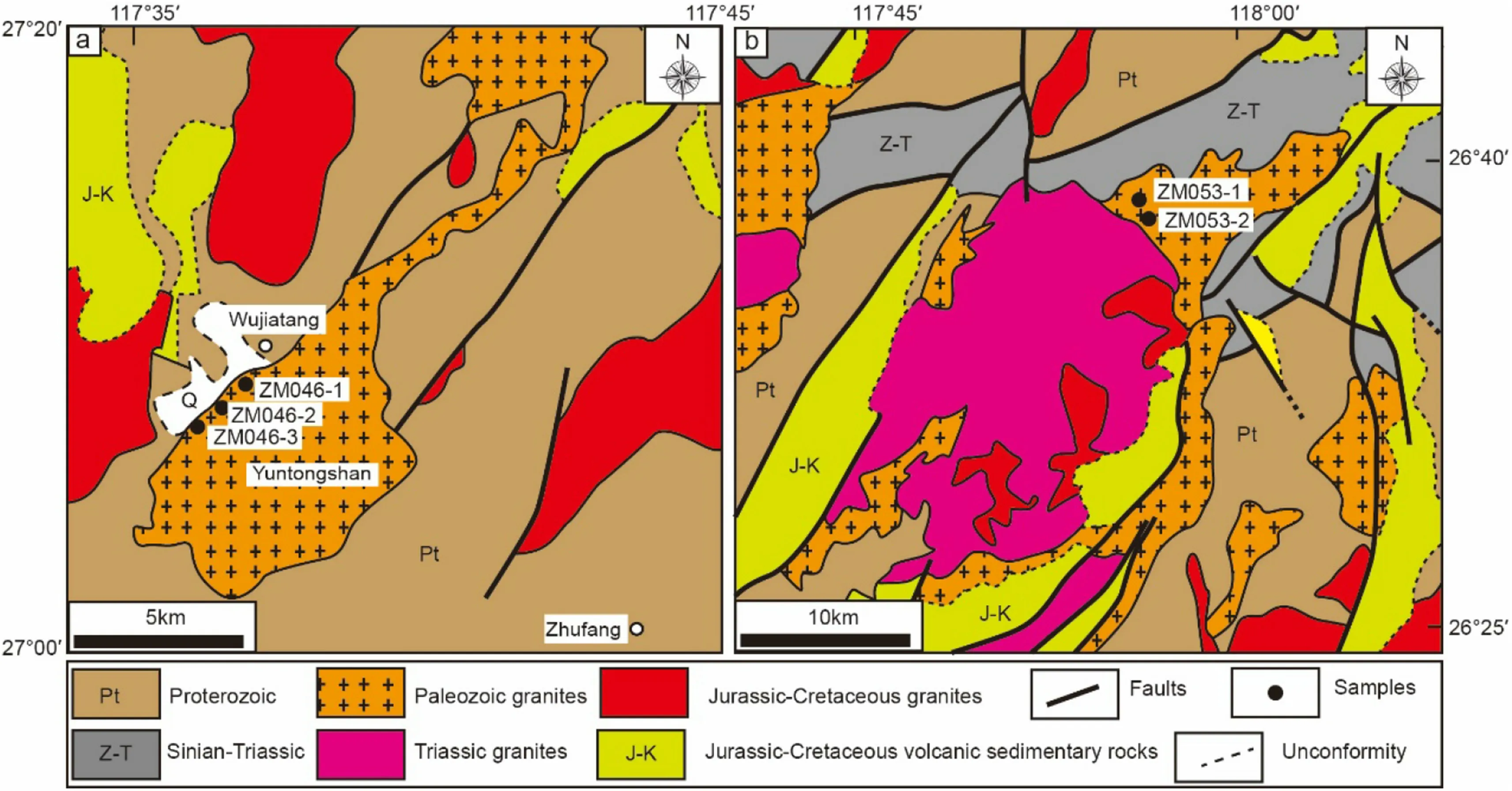
Fig.2 Geological maps of the Yuntongshan pluton (a) and Gaoqiao pluton (b)

Fig.3 a Field photograph of the Yuntongshan pluton(ZM46),b Photomicrographs of Yuntongshan monzogranite(ZM46);c Field photograph of Gaoqiao monzogranite (ZM53);d Photomicrographs of Gaoqiao monzogranite (ZM53),Abbreviations are as follows: Qtz: Quartz;Pl:Plagioclase;Kfs: Kfeldspar;Ms: White mica
The Gaoqiao pluton,located in the southeastern of the Yuntongshan pluton(Fig.1),covers an outcrop area of 128 km2and intruded into the Neoproterozoic Mayuan Group,which unconformably overlies Cambrian sandstone and slate and is overlain by Jurassic-Cretaceous volcanic clastic rock (Fig.2b).This pluton was intruded by Triassic granitoids(Gao et al.2019)and Jurassic-Cretaceous granitoids,exhibiting no obvious lithological zonation.Comprised primarily of granodiorite and biotite monzonitic granodiorite,it appears massive and is light grey to whitish colored(Fig.3c),with a medium-grained texture (Fig.3d).The biotite monzogranite mainly comprises plagioclase(~25%),K-feldspar (~25%),quartz (~25%),biotite(~20%),and hornblende (~5%) (Fig.3d).
3 Analytical methods
U–Pb dating of zircon was performed using LA-ICP-MS at Wuhan Sample Solution Analytical Technology Co.,Ltd.,Wuhan,China,following the operating procedures and data reduction methods described by Zong et al.(2015).A GeolasPro laser ablation system,equipped with a COMPexPro 102 ArF excimer laser (wavelength of 193 nm and maximum energy of 200 mJ) and a MicroLas optical system,was used for laser sampling.Ion-signal intensities were measured using an Agilent 7700e ICP-MS instrument,with helium serving as the carrier gas and argon as the make-up gas mixed with the carrier gas via a T-connector before entering the ICP.The laser ablation system included a ‘‘wire’’ signal smoothing device,as mentioned by (Hu et al.2015).The laser spot size was set to 10 μm,and the laser frequency was set to 1 Hz.For U–Pb isotope calibration,the uraninite standard GBW04420 was used as an external standard.Each analysis consisted of a background acquisition of approximately 20–30 s,followed by 50 s of data acquisition from the sample.Offline selection and integration of background and analyzed signals,time-drift correction,and quantitative calibration for U–Pb dating were performed using the Excel-based software ICPMSDataCal,as described by Liu et al.(Liu et al.2008).Concordia diagrams and weighted mean calculations were conducted using Isoplot/Ex_ver3 (Ludwig 2003).
The analysis of Hf isotopes was performed at the exact location where the U–Pb analysis was conducted.(Fig.4).The in-situ analysis of Hf isotopes was conducted using a Neptune Plus MC-ICP-MS from Germany,in conjunction with a Geolas HD excimer ArF laser ablation system.This laser-ablation system is equipped with a ‘‘wire’’ signal smoothing device,ensuring the generation of smooth signals even at extremely low laser repetition rates as low as 1 Hz.Helium was utilized as the carrier gas for the ablation material.For each measurement,the background signal was acquired for 20 s,followed by the acquisition of the ablation signal for 50 s.The ablation diameter was set at 44 m.Alongside the actual samples,two international zircon standards,namely 91,500 and GJ1,were simultaneously analyzed.The 91,500 standard was employed for external calibration to optimize the accuracy of the analytical results,while GJ1 served as a secondary standard for monitoring the quality of data correction.The instrument’s operating conditions and analytical method remained consistent with those described by Hu et al (2012).
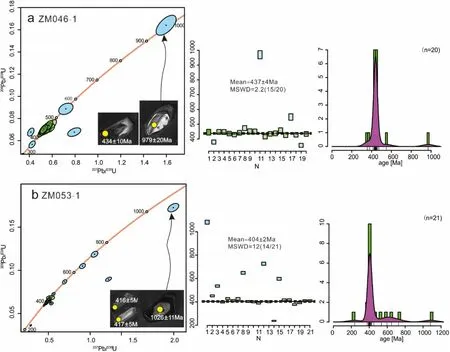
Fig.4 Representative zircon CL images of granitic rocks showing the sites of U–Pb dating and Zircon U–Pb concordia diagram of the granitic rocks,a ZM46 b ZM53
The Agilent 7700e ICP-MS at Wuhan Sample Solution Analytical Technology Co.,Ltd.,Wuhan,China,was utilized for conducting whole-rock chemical analyses.The detailed procedure for sample digestion was carried out as follows: (1) The sample powder (200 mesh) was dried for 12 h at 105 °C in an oven.(2) Accurately weighed 50 mg of sample powder was placed in a Teflon bomb.(3)Slowly,1 mL of HNO3and 1 mL of HF were added to the Teflon bomb.(4) The Teflon bomb was placed in a stainless steel pressure jacket and heated to 190 °C in an oven for more than 24 h.(5) After cooling,the Teflon bomb was opened and placed on a hotplate at 140°C until it reached incipient dryness.Then,1 mL of HNO3was added and evaporated to dryness again.(6) To the Teflon bomb,1 mL of HNO3,1 mL of MQ water,and 1 mL of a 1 ppm internal standard solution were added.The Teflon bomb was resealed and placed in the oven at 190 °C for more than 12 h.(7) The final solution was transferred to a polyethylene bottle and diluted to 100 g by adding 2% HNO3.
4 Result
4.1 Zircon U–Pb dating result
4.1.1 Yuntonghsan granite
Zircons from the Yuntongshan biotite granite (ZM046-1)exhibit long columnar crystals with aspect ratios of 1.5:1–2:1,particle sizes of 100–200 μm,and zircon Th/U ratios of 0.17–0.95,indicating magmatic zircon with oscillatory growth zoning as seen in CL images.U–Pb isotope analyses were conducted on 20 zircons,with results presented in Table 1 and Fig.4a.The206Pb/238U apparent ages of the 18 measurement sites,excluding measurement sites 11 and 17 which gave results for 979 Ma and 548 Ma years,ranged from 460 ± 10 to 418 ± 9 Ma and were relatively consistent.Fifteen measurement points fall on the concordia curve,and their206Pb/238U weightedaverage age was calculated as 437 ± 4 Ma (MSWD=2.2),representing the emplacement age of the Yuntongshan biotite granite.
4.1.2 Gaoqiao granite
Zircons from the Gaoqiao biotite monzogranite(ZM053-1)are mainly subhedral to euhedral crystals,with lengths ranging from 80 μm to 220 μm and length/width ratios of 1:1 to 4:1.CL imaging revealed weak,well-developed oscillatory zoning,with Th/U ratios spanning 0.1 to 1.29.U–Pb isotope analyses were conducted on 20 zircons,as presented in Table 1 and Fig.4b,with some ages concentrated in the range of 1026–536 Ma,and may indicate inherited zircons.The boundaries between inherited crystal nuclei and accretion are distinct,but their shapes vary,appearing as either rounded,sharply angular,or fragmented forms.Most zircon ages are concentrated in the range of 376–451 Ma,representing Early Paleozoic magmatic intrusive events.Of these zircons,fourteen yielded similar206Pb/238U ages ranging from 376 ± 4 Ma to 428 ± 5 Ma and provided a weighted-mean age of 404 ± 2 Ma (MSWD=12),representing the crystallization age.
4.2 Major and trace elements contents
4.2.1 Major elements The major element contents of the Yuntongshan granite and the Gaoqiao granite from central Wuyishan are listed in Table 2.The two granites had SiO2contents of 73.59%–75.91 % and high alkali contents (K2O=5.19 %–6.07 %,Na2O+K2O=8.31%–8.73 %).In the alkalis versus SiO2diagram,both the Yuntongshan and Gaoqiao granites lie within the field of sub-alkaline granite (Fig.5a).All the samples have ACNK (A/CNK=molar ratio of Al2O3/[CaO+K2O+Na2O)] ratios 0.96–1.17 (Table 2).In the plot of A/NK [A/NK=molar ratio of Al2O3/(K2O+Na2-O)]versus A/CNK shown in Fig.5b,these rocks fall into the field of metaluminous-strongly peralumious granites.The granites have greater K2O contents than Na2O.In the K2O vs.SiO2discrimination diagram,the samples lie within the field of the high-K series,demonstrating that they are potassiumrich granites(Fig.5c).
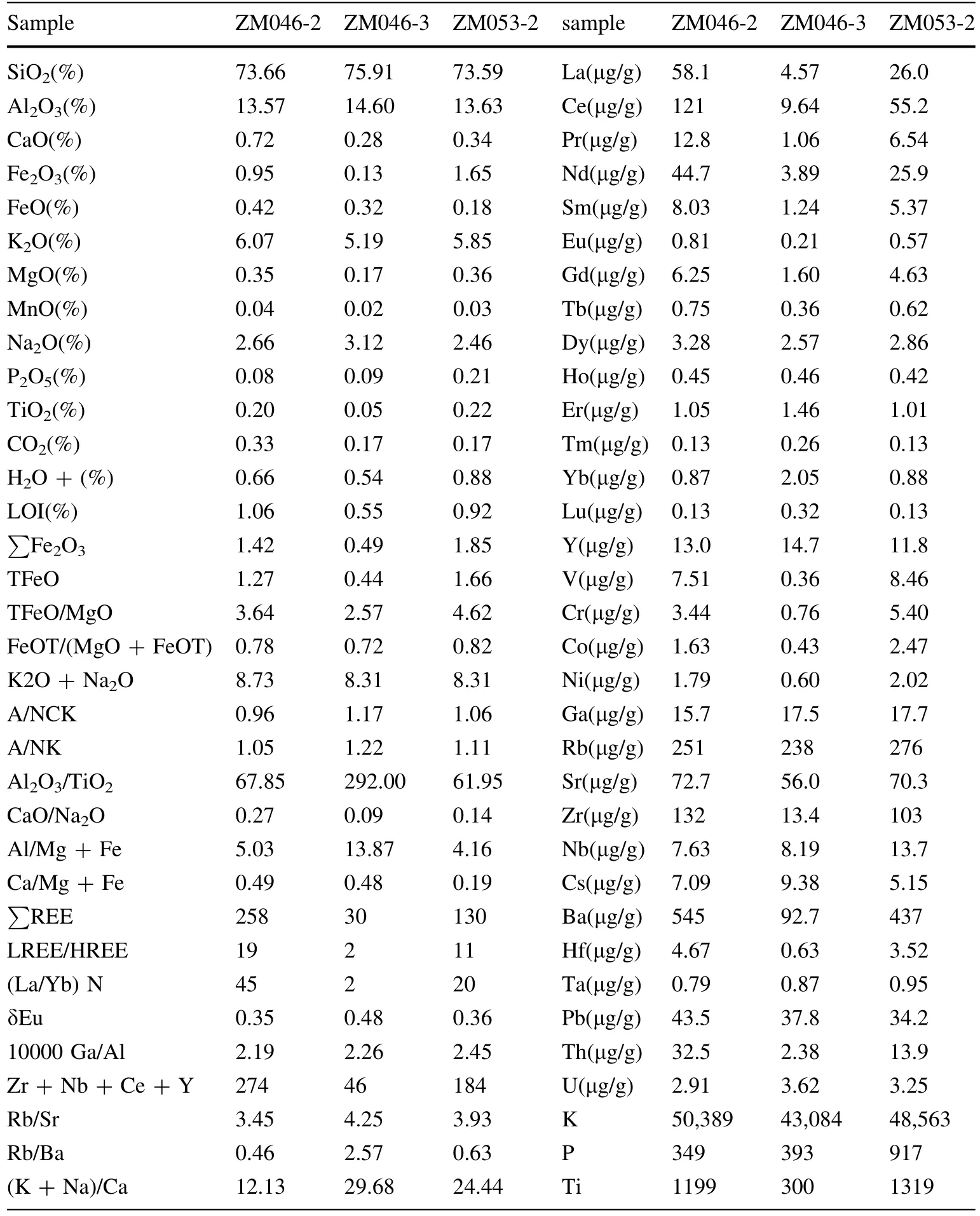
Table 2 Whole-rock major(wt%) and trace (ppm) element compositions for samples from Yuntongshan and Gaoqiao granites
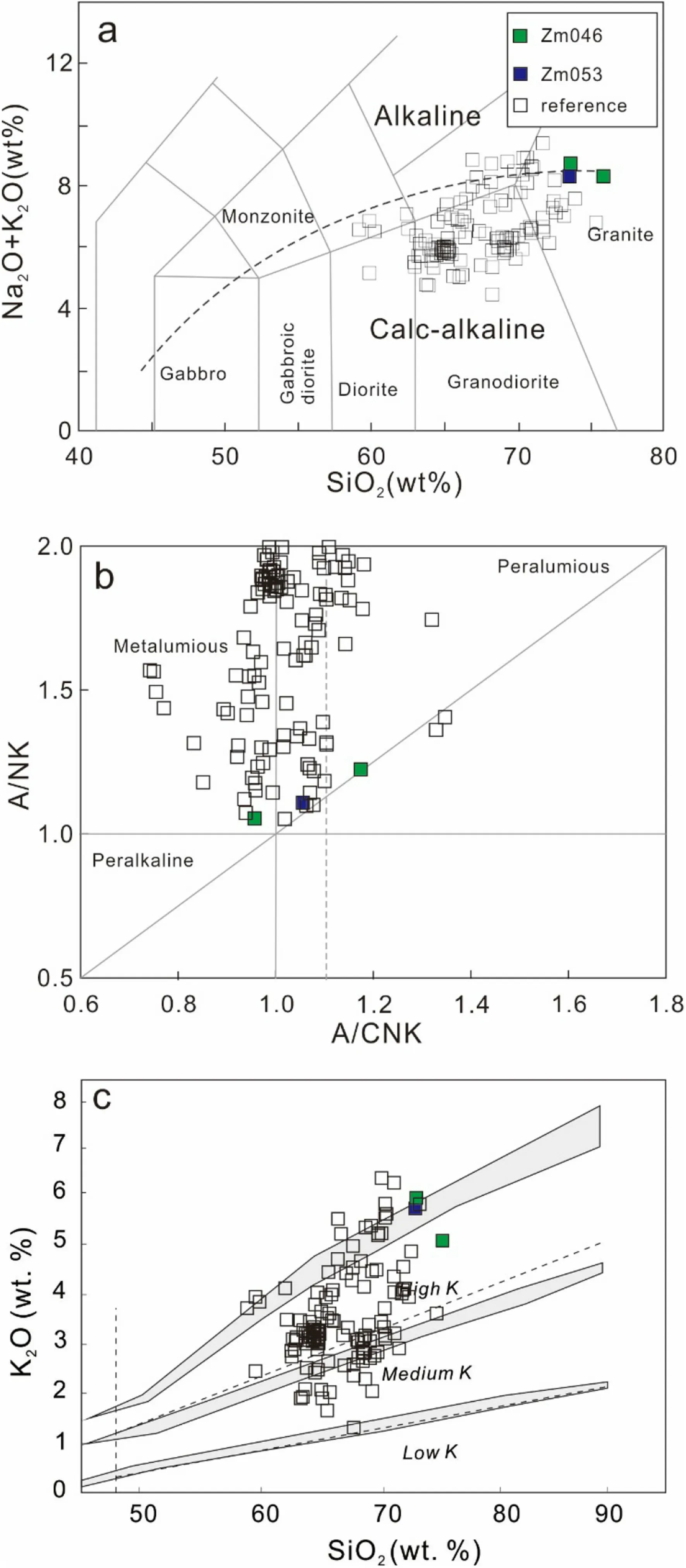
Fig.5 a Na2O+K2O vs.SiO2(Middlemost,1994)and b A/NK vs.A/CNK (Maniar and Piccoli,1989) and c K2O vs.SiO2 (Le Maitre et al.,1989) diagrams for the Yuntongshan and Gaoqiao pluton.The reference data are from(Cai et al.2017;Feng et al.2014;Dang et al.2018;Guan et al.2014;Jiang et al.2017;Zhong et al.2013;Xu and Xu et al.,2015;Zhang et al.2015a,b,c)
4.2.2 Trace elements
The ΣREE of Yuntongshan and Gaoqiao granites was between 30 and 258 ppm.Chondrite-normalized REE patterns are marked by enrichment in the LREEs(Fig.6a).LREE/HREE ratios vary between 2 and 19,and the (La/Yb)Nvalues range from 2 to 45.The fractionation of the light rare earth elements was more remarkable than that of the HREE.Furthermore,the negative Eu anomalies were significant,and the δEu values ranged from 0.35 to 0.48.
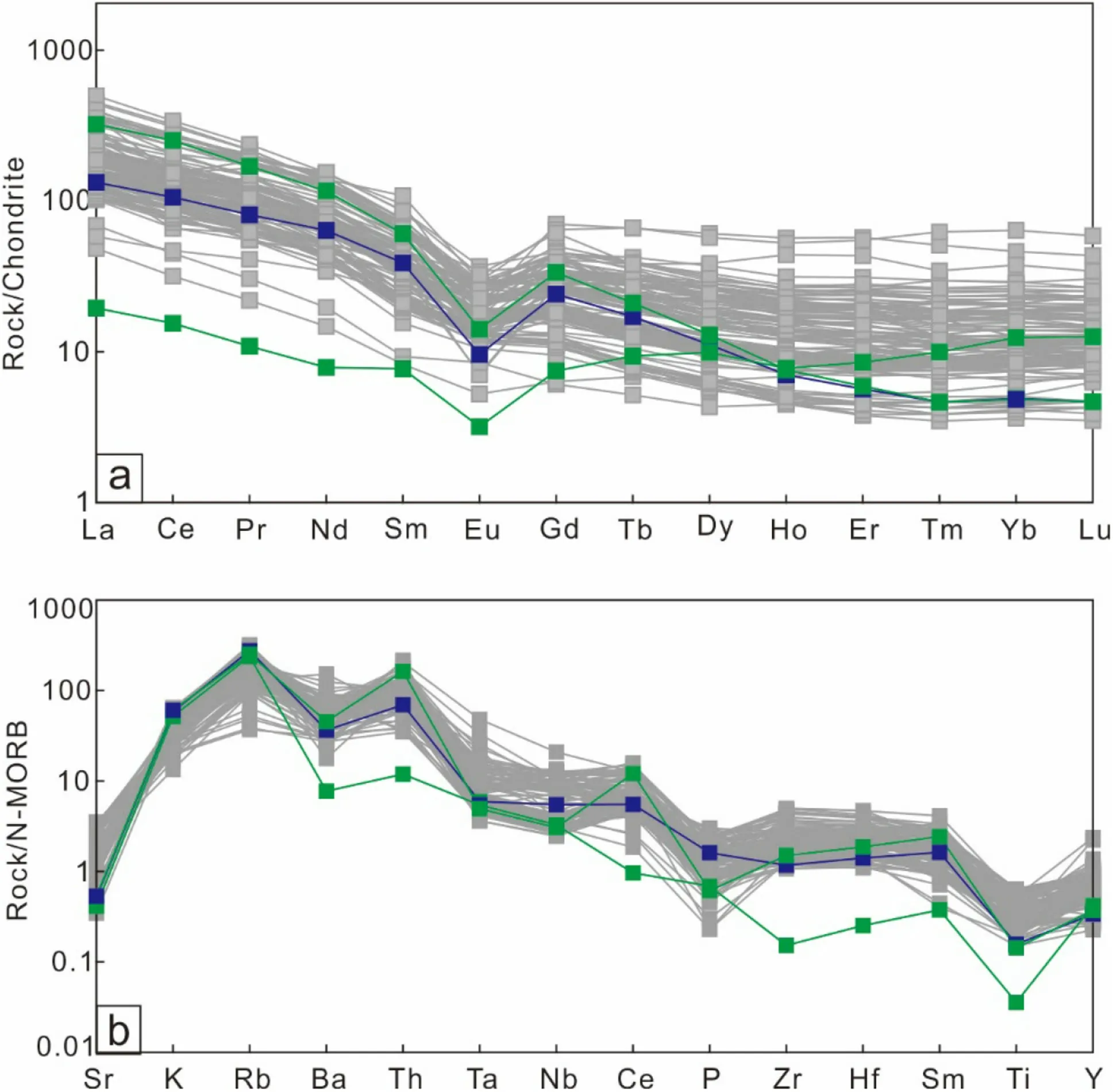
Fig.6 a Chondrite-normalized REE patterns (Boynton,1984) and b primitive-mantle-normalized element spider diagram (Sun and McDonough 1989) of the Yuntongshan and Gaoqiao granites.Symbols are as in Fig.5
In the spider diagram (Fig.6b),the Yuntongshan and Gaoqiao granites show enrichment in Rb,Th,and K,while depleted in Ba,Sr,Ti,and P.The variations in Rb,Ba,Sr,and Ti contents are mainly attributed to the differences in the rock-forming minerals.The elevated Rb and reduced Sr and Ba contents were caused by the fractional crystallization of K-feldspar,plagioclase,and biotite.
4.3 Zircon Hf composition
A total of 18 spots from the Yuntongshan pluton(ZM46-1)were analyzed for the Lu–Hf isotopic compositions ofzircon.The zircon Hf analyses were performed on the same domain of the same grain as those used for U–Pb dating(Fig.4).The εHf(t) values vary from -8.7 to -3.3(Fig.7a).The two-stage Hf isotopic model ages mainly vary from 1677 to 2040 Ma (Fig.7b).

Fig.7 Zircon Hf isotopic compositions of Yuntongshan and Gaoqiao granitic rocks:a–b histograms of zircon εHf(t)values and TDMC(Ga)of the Yuntongshan granitic rocks,respectively;c–d histograms of zircon εHf(t) value and zircon TDMC (Ga) values of Gaoqiao granitic rocks,respectively
A total of 16 spots from the Gaoqiao pluton (ZM053-1)were analyzed for the Lu–Hf isotopic compositions of zircon (Table 3).The εHf(t) values range from -16.3 to -7.8 (Fig.7c).The two-stage Hf isotopic model ages mainly vary from 1904 to 2829 Ma (Fig.7d).
5 Discussion
5.1 Petrogenesis and source
Granitic rocks are commonly classified as I-,S-,M-,and A-types(Chappell and White 1974,1992).Early Paleozoic granites in the study area exhibit typical peraluminous minerals and fall within the field of S-type granites,as shown by the diagram of Nb vs.Ga/Al and the unfractionated granites discrimination diagrams of Zr versus Ga/Al (Fig.8).These granites are mostly calc-alkaline,metaluminous to strongly peraluminous,with A/CNK <1.1 and A/NK >1.0,which are important criteria for the identification of S-type granitoids (Chappell and White 1992).Most coeval igneous rocks in the NW Fujian and adjacent regions are felsic rather than mafic,suggesting that the granites were formed by partial melting of ancient crust(Kong et al.2021;Xu and Xu 2017;Yan et al.2017).The absence of mafic magmatic enclaves in the Yuntongshan and Gaoqiao granitoid,and a diagram of Rb/Sr versus Rb/Ba shows that the Yuntongshan and Gaoqiao granitic rocks plotted in clay-rich sources (Fig.9),indicating the source is enriched in crustal material.These geochemical features suggest that their primary magmas were mainly derived from the partial melting of the lower crust,with the two-stage zircon Hf model ages indicating that the Paleoproterozoic basement might be the source of the granites(Fig.10).However,many Precambrian basement rocks in the Cathaysia block previously considered as Paleoproterozoic to Mesoproterozoic are Neoproterozoic(Wan et al.2007),which indicates that the source rocks of the early Paleozoic granites would be Neoproterozoic rather than Paleoproterozoic (Wan et al.2007;Yu et al.2012).In addition,inherited zircons from Neoproterozoic rocks were found in the Yuntongshan and Gaoqiao granites(Fig.4 and Table 1),providing direct age information about the source rocks.Therefore,it is inferred that the Gaoqiao and Yuntongshan granites were derived from the partial melting of Neoproterozoic basement rocks of the Cathaysia block.The coeval granitoids from E-SCB have similar Hf isotopic compositions,indicating a similar nature of the crustal sources (Wang et al.2012a;Xia et al.2014;Zhang et al.2012).
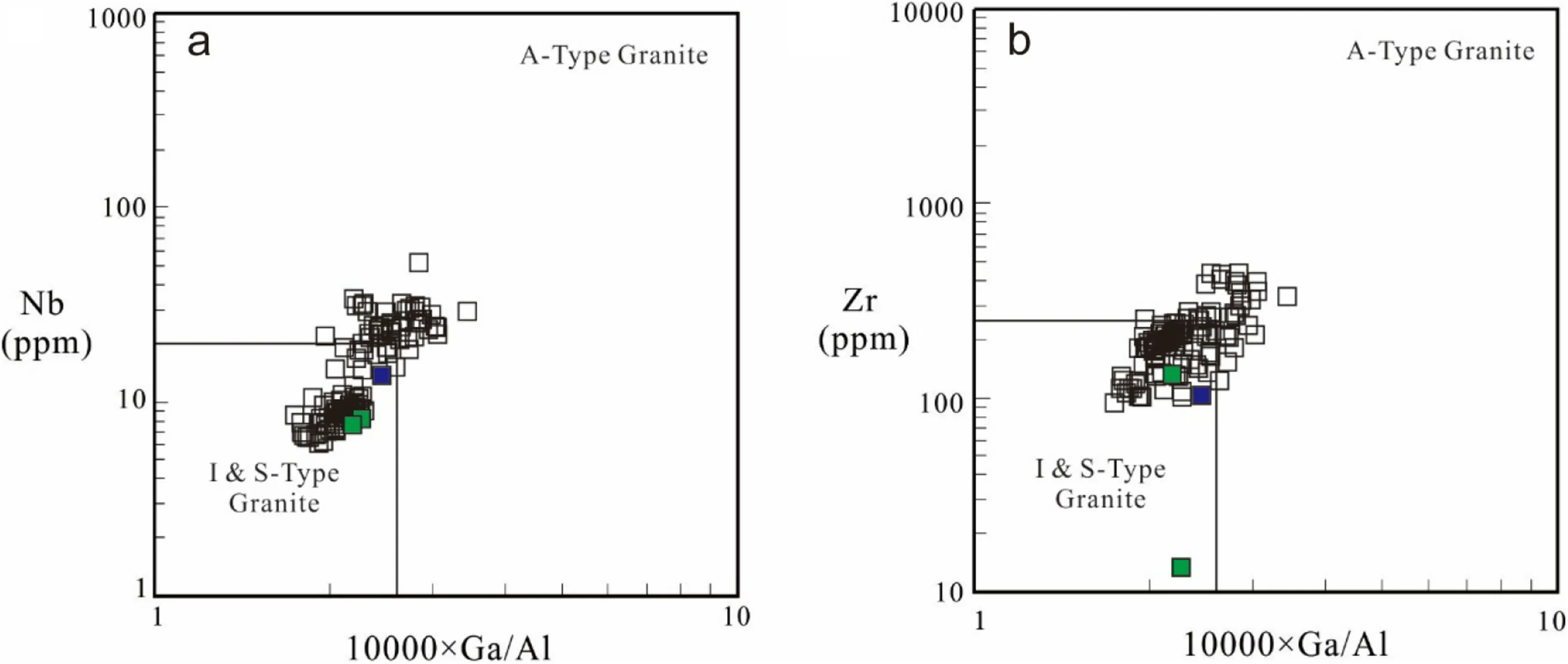
Fig.8 a Nb vs.10000 × Ga/Al and b Zr vs.10000 × Ga/Al diagram(Harrison and Watson 1984)for Yuntongshan and Gaoqiao granitic rocks;Symbols are as in Fig.5

Fig.9 Rb/Ba vs.Rb/Sr diagram for Yuntongshan and Gaoqiao granitic rocks (Sylvester,1998).Symbols are as in Fig.5

Fig.10 εHf(t) vs.age diagram for zircons from Yuntongshan and Gaoqiao granitic rocks with shaded areas denoting the previously published data from (Liu et al.,2016).Symbols are as in Fig.5
5.2 Early Paleozoic magmatism in Wuyi-Yunkai orogenic zone
Based on the available geochronological data of Early Paleozoic magmatism(Wang et al.2013a;Xin et al.2020),the Wuyi-Yunkai orogeny initiated in the Late Ordovician(~460 Ma),reached its peak during the Early to Middle Silurian (~440 to 430 Ma),and terminated in the Early Devonian (~400 Ma).This timing is consistent with the amphibolitic to granulitic metamorphism observed within the Wuyi-Yunkai Orogen(Li et al.2010).The granitoid magmatism analyzed in this study temporally coincides with regional magmatism and can be classified into three stages: syn-orogenic,transgressive,and post-orogenic(Xin et al.2020).Recent structural studies support a synorogenic (454–426 Ma) sinistral ductile shearing followed by post-orogenic(~400 to 370 Ma)exhumation and cooling in the Wuyi-Yunkai Orogen(Li et al.2017a).The age data suggests that crustal shortening occurred from approximately 460–420 Ma,with the peak occurring at around 460–435 Ma,and continued until about 420 Ma (Chu and Lin 2014;Faure et al.2009;Li et al.2016;Li et al.2017a;Li et al.2010;Sun et al.2018;Zhang et al.2018).During this time,anatexis occurred,leading to the formation of migmatites,leucosomes,and S-type granites,with most of the S-type granites being formed between ca.435 and 420 Ma (Liu et al.2010;Wang et al.2011;Wang et al.2012a;Wang et al.2013b).
While Huang and Wang(2019)suggest that parts of the orogen experienced lithospheric extension during the period of ca.435–420 Ma,the onset of the extension appears to be overlapped with crustal shortening(ca.460–420 Ma),as inferred from the structural and metamorphic records(Li et al.2016;Shu et al.2015;Zhang et al.2018).Additionally,A-type magmatism occurred during the Early to Middle Devonian in the Wuyishan and Yunkai areas.This includes the ca.415–413 Ma Huitong and Epo monzogranites (Feng et al.2014),the ca.412–409 Ma Xiqin K-feldspar granites(Cai et al.2017),and the ca.414 Ma Fufang granites(Xin et al.2020).The emplacement of A-type granitoids and diabase between ca.415–403 Ma indicates that at least parts of South China evolved into a post-orogenic phase of extension during the Early Devonian.However,despite the occurrence of a few A-type granites and basal veins,the emplacement of S-and I/Stype granites continued.

On the tectonic setting discrimination diagrams(Fig.11),the Yuntongshan granite (~437 Ma) falls into the syn-collision fields.In contrast,the younger Gaoqiao granitoids (~404 Ma) also plot in the syn-collision field and were likely related to a post-orogenic extension setting(Huang and Wang 2019;Huang et al.2013),in good agreement with the occurrence of~420 Ma post-collisional gabbroic rocks(Zhang et al.2015b).The transitional I-S granites,mostly postdating ca.435 Ma,were formed by ongoing partial melting of crustal rocks but were likely modified by upwelling mafic magmas (Xia et al.2014).However,due to the lack of coeval accretionary complexes,volcanic arc rocks,or subduction-related rocks,especially ophiolites sourced from the asthenospheric mantle adjacent to the Wuyi-Yunkai tectonic belt,the arc signature observed in the Yuntongshan and Gaoqiao granites is more likely inherited from the source rocks rather than related to coeval oceanic subduction.We conducted statistical analysis and mapping on the Late Paleozoic granitic bodies published in the region.These bodies include A-type,I-type,and S-type granites,each with different petrogenesis.However,they were all formed in a tectonic setting transitioning from orogeny to post-orogenic processes.The published data,along with the data provided in this study,collectively reflect the magmatic activity within the intracontinental orogeny.Compared to magmatic activity at plate margins during orogeny,magmatic activity within the intracontinental environment may be more complex.
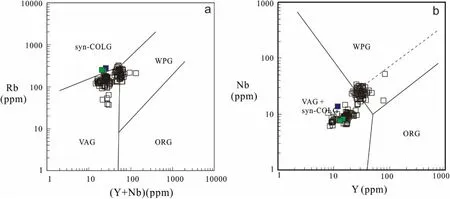
Fig.11 Discrimination diagram showing the tectonic settings of Yuntongshan and Gaoqiao granitic rocks(Pearce et al.,1984).a Y+Nb vs.Rb,b Y vs.Nb;Abbreviations are as follows: WPG=within-plate granite,VAG=volcanic arc granite,syn-COLG=syn-collisional granite,ORG=oceanic ridge granite.Symbols are as in Fig.5
5.3 Tectonic setting and geological significance
Based on various studies that have been conducted on the Wuyi-Yunkai orogeny,there have been different opinions on the cause of this orogeny.Some researchers argue that it was a result of oceanic subduction-collision (Liu et al.2018;Zhang et al.2015a,2016),while others suggest that it was an intraplate orogeny (Faure et al.2009;Yan et al.2017;Zhang et al.2012).The former theory is unable to be confirmed due to a lack of evidence of Early Paleozoic ophiolite suite,subduction complexes,and volcanic arc belts in the SCB (Shu et al.2014).Additionally,the absence of synchronous mafic rocks and deep marine environments further casts doubts on this theory(Shu et al.2014;Wang et al.2010).On the other hand,the continuity and similarity of detrital zircon age spectra,as well as the consistency of paleocurrent,biostratigraphy,and paleoecology data,strongly suggest that the Yangtze Block was not separated from the Cathaysia Block during the Early Paleozoic (Lyu et al.2020;Yu et al.2015).
Although some coeval arc-like magmatic rocks have been discovered in the Wuyi-Yunkai orogeny (Liu et al.2018;Zhang et al.2015a,b,2016),their sources remain a topic of debate.Most of these rocks have negative εHf(t)values and old TDM ages of around 1 Ga,indicating that they are derived from an enriched mantle that has been metasomatized by slab-derived components(Liu et al.2018).Moreover,the absence of mafic rocks with high positive εHf(t) values,particularly ophiolites in this subduction system contradicts the oceanic subduction-related rocks proposed by certain researchers(Wang et al.2013a).In contrast,the intraplate orogeny theory is highly plausible,as it is characterized by crustal shortening and thickening,mountain uplift and exhumation,and mediumto high-grade metamorphism (Shu et al.2014;Xu et al.2016;Yu et al.2015).However,the significant distinction between it and the collisional orogeny is the lack of coeval oceanic subduction-related or continental collision-related HP–UHP metamorphic rocks (Raimondo et al.2014).
The SCB,where the Wuyi-Yunkai orogeny is located,was once close to Australia,which was considered as the northern part of East Gondwana during the Early Paleozoic.This closeness was supported by paleomagnetic data and studies on detrital zircons (Huang et al.2018;Zhang et al.2015c).The southeastern SCB,Indochina block,Simao block,and Sibumasu block are more likely to be connected to the Indian continent or located between the junction of the Indian and Australian continents (Cawood et al.2013;Yu et al.2015;Zhao et al.2017),which were part of the North Indo-Australian Andean-type active continental margin and constituting the southern branch of the Proto-Tethys or its southern boundary (Wang et al.2022).The southern branch ocean started to close around 480 million years ago.The orogenic process completely ceased around 410 Ma ago(Wang et al.2022).In addition,the Alice Springs intraplate orogeny in central Australia controlled by the Terra Australis accretionary orogenic process,which was triggered by the Proto Pacific Ocean subduction persisted from 460 to 300 Ma ago (Raimondo et al.2014).In conclusion,during the late Early Paleozoic,the subduction-closure of the Proto-Tethys and Proto-Pacific oceans likely together provided the driving force for the Wuyi-Yunkai orogenic activities (Fig.12).
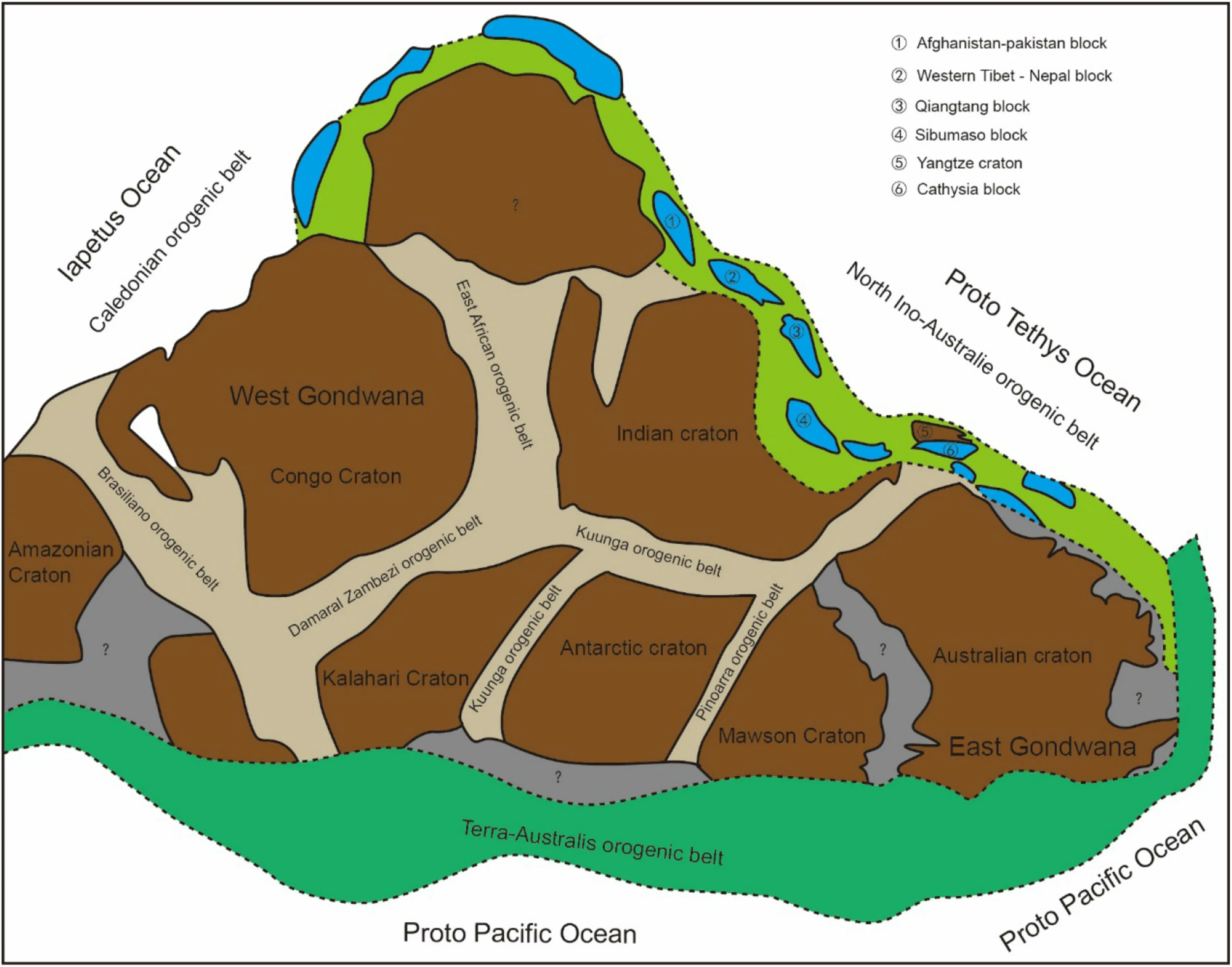
Fig.12 Reconstruction Model map of Early Paleozoic Gondwana supercontinent,modified from (Wang et al.2022)
6 Conclusion
Our research,which utilized LA-ICP-MS U–Pb zircon dating,has revealed that the Yuntongshan and Gaoqiao granites intruded the Precambrian basement in the Early Paleozoic period at 437 ± 4 Ma and 404 ± 2 Ma respectively.In situ Hf isotopic analyses of zircon have also indicated that their primary magma probably originated from Neoproterozoic crustal materials.
Furthermore,the geochemical characteristics of both Yuntongshan(437 Ma)and Gaoqiao(404 Ma)granites are consistent with those of S-type granites,indicating that they were formed during the transformation-post-collisional phase of intraplate orogeny.This suggests that their formation may be related to the subduction-closure of the marginal ocean of the East Gondwana supercontinent.
AcknowledgementsThe authors are grateful to the anonymous reviewers for their extremely useful comments,which significantly improved the manuscript.We are indebted to Li Gao,and Yongyan Guo for assistance with the zircon LA–ICP–MS analyses.This study was supported by the National Natural Science Foundation of China(No.41702204),the Central Fundamental Research (grant number DZLXJK201504),and the Major State Research Development Program of China (grant number 2016YFC0600202).
Author contributionsWG performed the conceptualization,formal analysis and writing;ZW performed the validation,review &editing the original draft and supervision.
Declarations
Conflict of interestThe authors declare that they have no conflict of interest.
杂志排行
Acta Geochimica的其它文章
- Geochemistry and mineral chemistry of the armoor granitoids,eastern dharwar craton: implications for the redox conditions and tectono-magmatic environment
- Mineralogy and geochemistry of trachytic rocks from the Lichi Volcanics,Eastern Himalaya: insights into the Kerguelen mantle plume activity in the Eastern Himalayan Region
- Solute transport and geochemical modeling of the coastal quaternary aquifer,Delta Dahab Basin,South Sinai,Egypt
- Geochemistry,zircon U–Pb geochronology,and Hf isotopes of S-type granite in the Baoshan block,constraints on the age and evolution of the Proto-Tethys
- Distribution,health and ecological risk assessments of trace elements in Nigerian oil sands
- Petrogenesis and tectonic implications of the Silurian adakitic granitoids in the eastern segment of the Qilian Orogenic Belt,Northwest China
